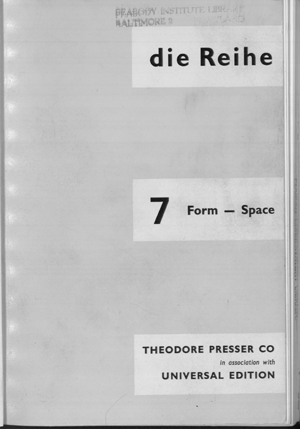Die Reihe [English-language edition]
Prepared by Richard Kitson
Online only (2018)

The German-language periodical Die Reihe [The series. REI] was published spasmodically by the Universal-Edition, Vienna, between 1955 and 1962 in eight large volumes. The great interest in the new directions in musical composition created immediately after the conclusion of the Second World War and featured in this journal, prompted preparation and publication of an English-language translation, printed in England by The Stellar Press, Ltd. at Barnett (Nos. 1-5) and by John Blackburn, Ltd. at Leeds (Nos. 6-7), and issued from 1958 to 1968 by the Theodore Presser Company of Bryn Mawr, Pennsylvania, in association with the Universal-Edition. The printer of issue No. 8 is unknown. The pages are printed in single space format. Each volume contains a different number of pages varying from 62 to 136. The English-language translations of the complex texts were prepared by Hans O. Holms, Leo Black, Eric Smith, Cornelius Cardew, Ruth Koenig and Margaret Shenfield.
The original volumes were edited by two well-known specialists in the various fields of new music. Herbert Elmert (1897-1972) was a composer and musicologist who was active with the Cologne Radio (NWDR) and undertook the direction of the Cologne Studio for Electronic Music from 1951 to 1962, assisting a number of composers interested in the composition of electronic music including Ernst Krenek, Karlheinz Stockhausen, Iannis Xenakis and Bernd Alois Zimmermann. Elmert was a lecturer at the Darmstadt Internationale Ferienkurse für neue Musik [International Vacation Courses for New Music], 1951-57. Karlheinz Stockhausen (1928-2007) a student of Olivier Messiaen and Werner Meyer-Eppler, an important composer of twelve-tone, serial and electronic music, a leading figure at the Darmstadt School and other educational institutions, was an important yet controversial figure in the new music of the post-war period. He succeeded Elmert as Director of the Cologne Studio for Electronic Music.
Each issue of REI is titled to reflect the various themes of the articles. Vol. I (1955/1958) is titled “Electronic music.” Herbert Elmert explains the violent controversy of music produced by electronic means; H. H. Stuckenschmidt presents observations on the aesthetics of electronic music; Ernest Krenek re-examines the systematic formulation of musical materials in the light of new methods; Pierre Boulez discusses radically different approaches to composition in the electronic and acoustical domains; Karlheinz Stockhausen explains the combination of sung speech and electronic sound. Vol. 2 (1955/1958) is entirely devoted to the life and works of Anton Webern (with considerable attention given to Arnold Schoenberg, Webern’s teacher) in articles by Boulez, Stockhausen, Krenek and Stravinsky. Vol. 3 (1957,1959), entitled “Musical craftsmanship” in which Herbert Elmert discusses the theory of the freedom of choice (cybernetics); Stockhausen discusses the durations and pitches as phases or alterations in an acoustic field; John Cage explains the seven steps required in the creation of the notation of “chance operations”; Henri Pousseur outlines a method of compositional craftsmanship.
Vol. 4 (1958/1960) features “Young composers.” Wolf-Eberhard von Lewinski discusses the wide gap in contemporary life that brings about entertaining and unentertaining music; the new composers Luigi Nono, Henri Pousseur, Hans Werner Henze, Pierre Boulez, Bo Nilsson and Luciano Berio are treated in biographical sketches and analyses of important compositions by various authors. Vol. 5 (1959/1961) contains "Reports. Analyses" including Elmerts reassessment of Debussy’s ballet Jeux ; Heinz-Klaus Metzger’s analysis of concepts in the theory and criticism of music; Maurizio Kagel deals with Henry Cowell’s “theory of relativity”; György Ligeti explains Boulez’s method of dealing with the proportion between strictly composed and freely interpreted music; John Cage’s lecture “Interdeterminacy” is reproduced. Vol. 6 (1960/1964), titled “Speech and music” contains Hans Rudolf Zeller’s discussion of the French poet Mallarmé absolute language and serialism; Dieter Schnebel’s thoughts on Debussy’s Prélude Brouillards without theme and development; Stockhausen analyses Boulez’s Le Marteau sans maître. In Vol. 7, “Form space,” György Ligeti explains Schoenberg’s twelve-tone technique spread over the totality of form; Ursula Burghardt-Klagel introduces Amanico Williams’ space theatre; John Whitney describes an abstract motion picture based on Schoenberg’s twelve-tone principles. The final volume entitled “Retrospective” (1962/1968) includes Werner Meyer-Eppler’s broadcast on acoustics and information theory; Helmut Kirchmeyer on rationalistic music; Walter Schulze-Andresen on a three-dimensional stave; and Adrian D. Fokker poses questions relating to the new music.
